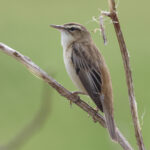A week-long International Tour to Extremadura in Spain, organised together with our friends from Oriole Birding. We had a couple of showery mornings, but the weather was generally very good, with some sunshine for most of the week, and nice temperatures, warm but not too hot. Perfect for birding!
SUNDAY 31ST MARCH
Our flight from Gatwick arrived early into Madrid, but the car hire company was typically chaotic – our minibus had to be brought in from off-site and a Spanish ’10 minutes’ turned into quite a bit longer, particularly when they forgot they had to give us the keys! Eventually we got away and set off for the long drive down to Trujillo.
Our first birds in the outskirts of the city were Spotless Starlings, which were then a regular feature of the journey. As expected in this part of Spain, there were plenty of raptors to be seen from the road – several Black Kites, a couple of Marsh Harriers, Eurasian Kestrels and a Common Buzzard on post. As we got out into the open countryside, we started to see White Storks with many perched on large stick nests on buildings or pylons and one or two flying rather too low for comfort over the road. A couple of large flocks of Cattle Egrets were seen in the fields too. Unlike back home, there were lots of hirundines already in here – mainly Barn Swallows, plus a small group of House Martins. There were a few Common Swifts too and two Alpine Swifts flew over as the road crossed a deep river valley on a high bridge.
We only had time for a quick stop today at one of the services on the motorway, where three Crested Larks were running around in the car park. Continuing on our journey, a couple of Eurasian Hoopoes crossing the road confirmed we were now very much in southern Europe.
It was already late by the time we arrived at our hotel just outside Trujillo. After checking in, it was straight down for a welcome drink followed by a delicious dinner of local dishes. Most of the group had already retired to bed when those heading across the courtyard to their rooms heard a Eurasian Scops Owl singing in one of the trees in the front garden and managed to find it using a torch, perched up in the branches.
MONDAY 1ST APRIL
With the clocks having gone forward yesterday, it was still dark as we went down to breakfast this morning. The Scops Owl was singing in the garden again, and when we went out to listen we could hear a Woodlark singing in the pitch black too. After breakfast, as we were loading up the minibus, our first Iberian Magpies of the trip flew in across the road in a big mob.
We headed out onto the plains near Santa Marta de Magasca for the morning and at our first stop we were soon enjoying lots of singing Corn Buntings and Crested Larks. Two or three Northern Wheatears ran around on the short grass behind us and a flock of Spanish Sparrows whirled round. Our first Great Bustard was walking about in the grass among some bushes, a male, and a quick scan revealed a female nearby too. Another Great Bustard flew past, low overhead.

Then a Black Kite flew over too, and landed on a road sign nearby, while a couple more Black Kites circled over the hillside beyond together with a single Red Kite, and both Iberian Grey Shrike and Woodchat Shrike perched up on isolated bushes out in the short grass.
Moving on, we turned onto a rough drovers track and stopped again. A single male Great Bustard was partly puffed up on top of the ridge on one side, while another male was in full ‘foam bath’ display among some cattle on the other side. We eventually spotted a female Great Bustard nearby, when the cows moved, which was the target of his advances. When we heard Pin-tailed Sandgrouse calling, we looked up to see six flying high over the fields and we watched them drop down and land in the field by the bustards, where we got a good view of them in the scope, as another two flew in to join them.
Two Great Spotted Cuckoos were chased by a Eurasian Magpie, and landed in a bare bush up on the ridge, while we could hear a Common Cuckoo singing further over. Lots of Calandra Larks were flying round over the plains, singing – we could see their black underwings with a broad white trailing edge. There were more raptors here. A Black Vulture was standing in one of the fields, and several more Red Kites were on the ground too, including one with coloured wing tags. A couple of Common Buzzards flew across and a distant Little Owl was perched on the roof of an old barn.
While standing here, we heard a Little Bustard singing, an odd sound like a cross between someone blowing a raspberry and a frog! It was close by but we couldn’t see it, as it was just over a low ridge in the grass. After changing position several times to try to get an angle from which we could see it, finally it walked out into view and we could see its puffed out black and white neck, and we watched as it threw its head back as it sang.
It started to spit with rain now, so we drove down to the Rio Magasca river crossing for a coffee break. A quick walk down to the bridge afterwards added a couple of White Wagtails and a Grey Wagtail down by the river, singing European Serin and Cetti’s Warbler, with Crag Martins and Red-rumped Swallows whirling overhead. A European Bee-eater flew high over the gorge calling but a Rock Sparrow unfortunately flew off before anyone could see it.
As the rain started to fall more heavily, we hurried back to the minibus and moved on. A quick stop at a high point in the road produced a few more vultures standing around in the fields, mostly Griffon Vultures, and another Little Bustard displaying on a ridge behind us. A slow drive along the road across the steppes produced lots of larks, Meadow Pipits and Corn Buntings on the tarmac, presumably trying to get away from the wet grass.
Then as the rain finally started to ease again we made our way down to the Rio Almonte crossing for lunch. Lots of Barn Swallows and House Martins hawking low over the water were possibly migrants pushed down by the weather, because when the eventually stopped they circled up and moved on. Down along the river bank three Little Ringed Plovers, a Common Sandpiper and a European Robin were all welcome additions to the trip list.
Continuing on through Monroy, we stopped by a group of stone pines where several White Storks were perched high up on their nests. Finally the weather started to brighten up, and as we walked down the track, we found a couple of Thekla Larks, several Northern Wheatears and a pair of European Stonechats in the fields. A small group of Rock Sparrows flew up from the grass, flashing their white tail tips, and landed on the fence where we could all admire their head stripes. A singing Common Quail was well hidden in a thick wheat crop but a Hoopoe eventually gave itself up when one of the group found it in a small olive orchard. Several Iberian Magpies flew back and forth across the track.
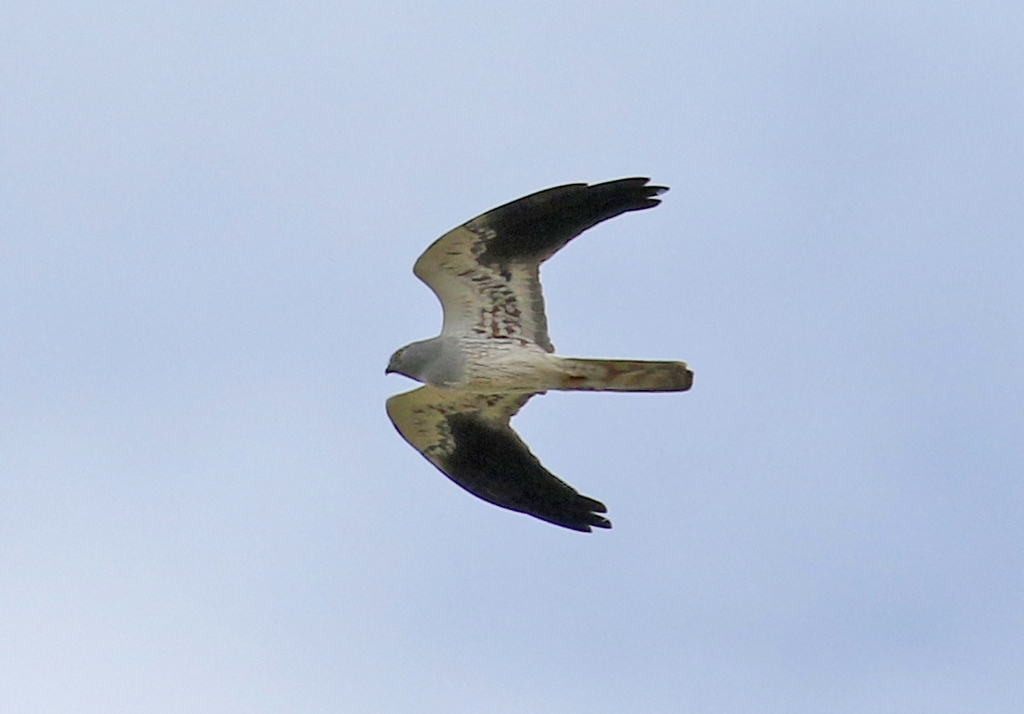
More raptors started to circle up now. Mostly Griffon Vultures at first, followed by a couple of distant Booted Eagles, then one much closer with a Marsh Harrier. A cracking male Montagu’s Harrier drifted low overhead. A kettle of White Storks circled up from the fields over the ridge, and a Black Vulture joined them. As the storks flew low back our way towards the pines, the Black Vulture came right over our heads too giving us a really close view.

As we drove back towards Trujillo, a Great White Egret was standing by a pool beside the road, another new bird for the trip. We still had time for a stop at the bullring, where we stopped first to get a good look at the Spotless Starlings on the roof in the sunshine. Several Lesser Kestrels were zooming around in the sky above, with at least eight all together at one point.

A White Stork flying over was carrying a piece of plastic sack as nest material – it seems like plastic gets everywhere these days. Then it was time to head back to the hotel. As we drove up the track through the fields, we stopped to watch a female Sardinian Warbler wrestling with a large hairy caterpillar in the middle of the road.
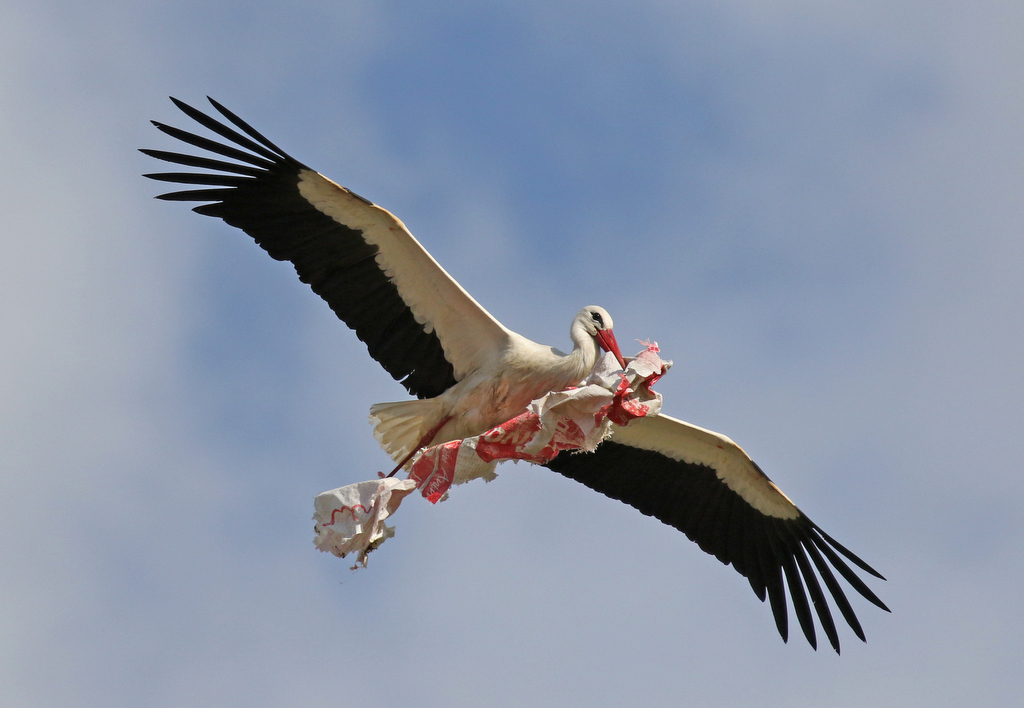
TUESDAY 2ND APRIL
The sun was just rising as we got out to Belen and it was a great view from the edge of the village looking out across the plains. A Hoopoe was calling as we got out of the minibus and a Red Fox was out in one of the fields. Scanning the rocks on the neighbouring slopes revealed a single Stone Curlew preening, which we had a good look at in the scope. There were also a few Northern Wheatears, a Thekla Lark and a Little Owl perched on a rock. Rather unexpectedly, a Green Sandpiper flew past. Three Great Bustards were very distant dots out on the plains.
As we drove slowly down the road, we heard a Little Bustard singing. We stopped and got out and managed to find it on a small patch of short grass on some slightly higher ground. It was displaying, its black and white neck puffed out. From time to time, it would stomp its feet several times and then leap into the air flapping its wings. Great to watch! Several Calandra Larks were singing too. Further on, two more Great Bustards were on a distant hillside.

https://www.youtube.com/watch?v=otvgbi34EZUWe were heading for Monfrague this morning, so we cut across back towards the El Torrejon road. There were lots of small pools along here and we found a small party of Eurasian Spoonbills feeding on one as we passed by, a single Little Grebe on another and a Great White Egret too.
As we got up into the hills, we had a very brief stop at Arroyo de la Vid. It was rather quiet here apart from several European Serins singing, although one of the group had a brief Subalpine Warbler which was identified retrospectively. Then we continued quickly on to the Castillo before it got too busy there.
As we got out of the minibus, the first Griffon Vulture sailed low overhead, just over the tops of the trees, a taste of things to come. From up at the top by the Castillo, more vultures were passing at eye level or below, very close – quite a spectacle. Mostly Griffons at first, then joined by one or two Black Vultures, at least two Egyptian Vultures, a Booted Eagle and one or two Black Kites. It was a proper raptor-fest!
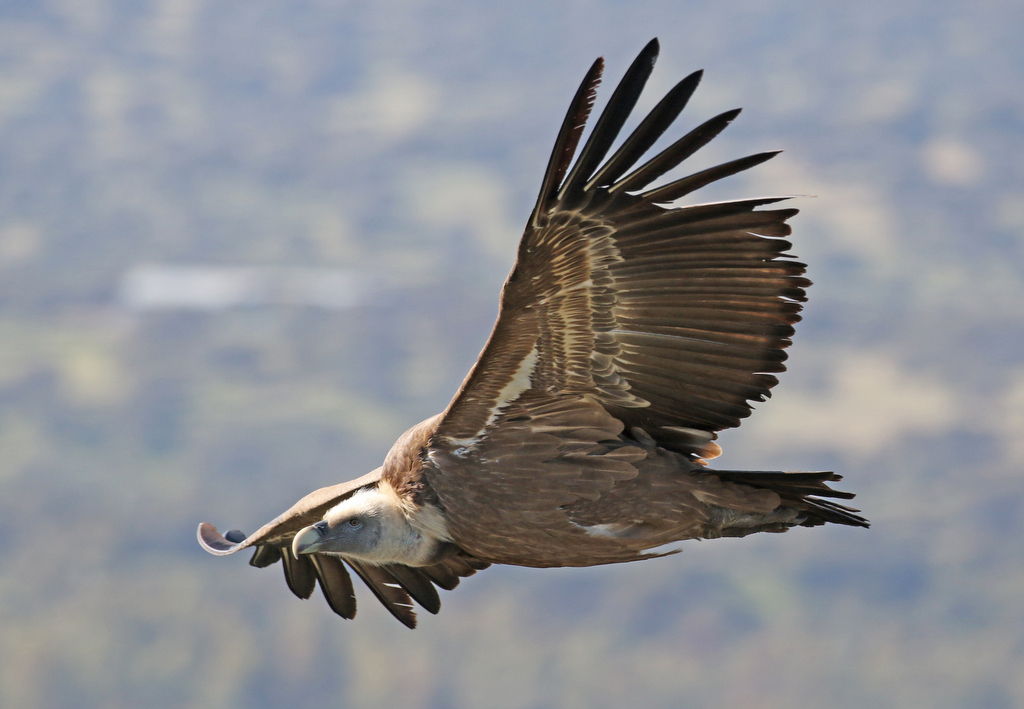
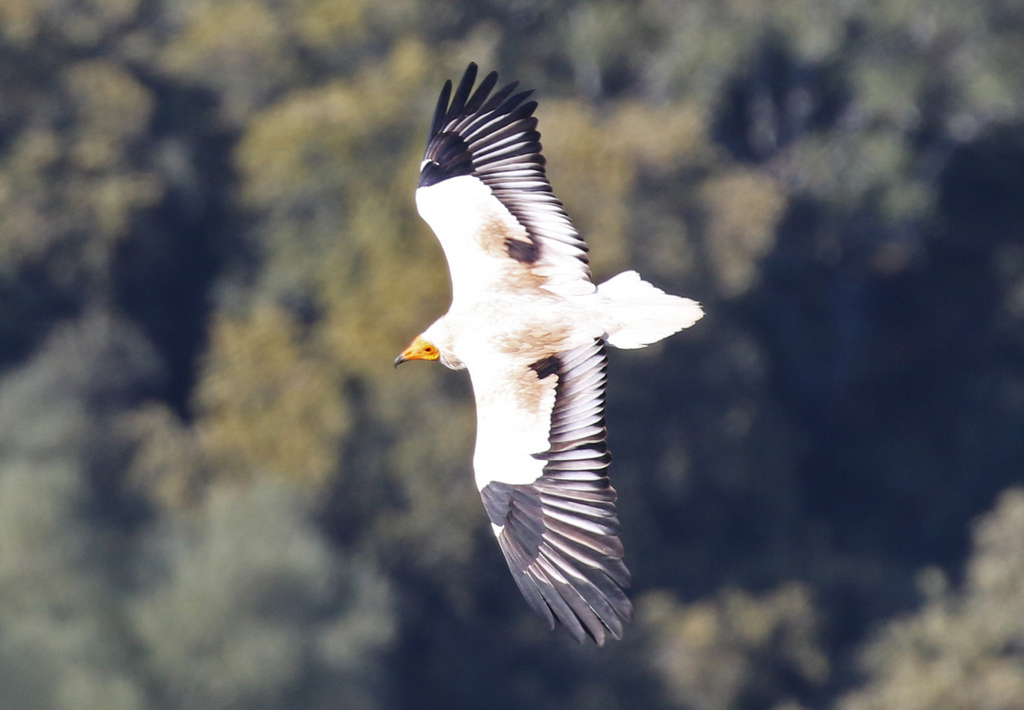
We also saw our first Black Stork circle up in front of the crag beyond and two male Blue Rock Thrushes perched on the rocks, although they were rather distant from here.
Tearing ourselves away from all the activity at the Castillo, we headed back down and stopped for coffee at the Salto del Gitano mirador. There were lots more vultures here, including several close Griffon Vultures perched on the rocks which filled the frame in the scope. A Peregrine high above tussled with some of the vultures, and looked positively tiny by comparison as it swooped at them, and an Osprey flew past following the river valley.

We had closer views of Black Storks here, coming in to land on the cliffs opposite where they were nesting, and better views of Blue Rock Thrushes feeding around the rocks just below us, together with Black Redstarts and a Rock Bunting. As well as numerous Sardinian Warblers, a Subalpine Warbler perched up briefly, which allowed everyone to add it to their lists.

After stopping for lunch at Villareal, we continued on through the park. It was hot now, but the raptors at least were still active. At Mirador La Bascula, our first Short-toed Eagle drifted over and then while we stopped to scan the surrounding hills at La Higuerilla there were yet more vultures, Black Kites and a couple more Short-toed Eagles. Two Red Deer were bathing down in the river below and we got some really good views of a male Subalpine Warbler in the trees by the car park. We were hoping we might find Spanish Imperial Eagle from here, but there was no sign.
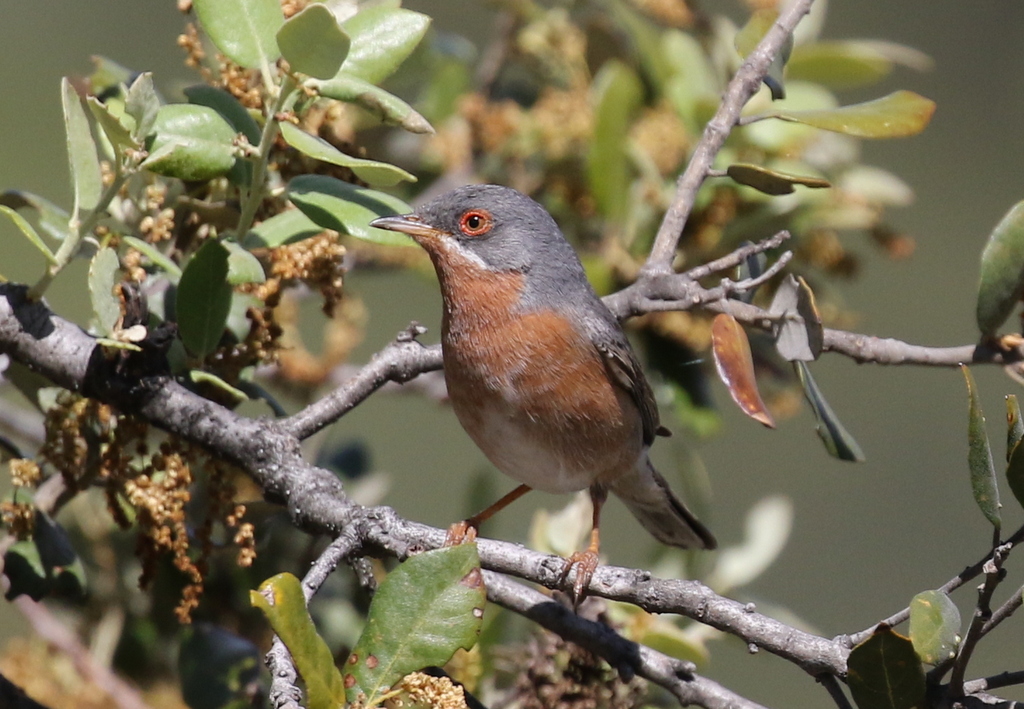
Stopping next at the mirador at Portilla del Tietar, another Black Stork circled over the gorge and we could see lots more Griffon Vultures nesting on the rocks opposite. A small flock of Rock Doves flew across the cliff, presumably close to genuine pure birds here, and two Crag Martins and several Red-rumped Swallows zipped round just overhead.
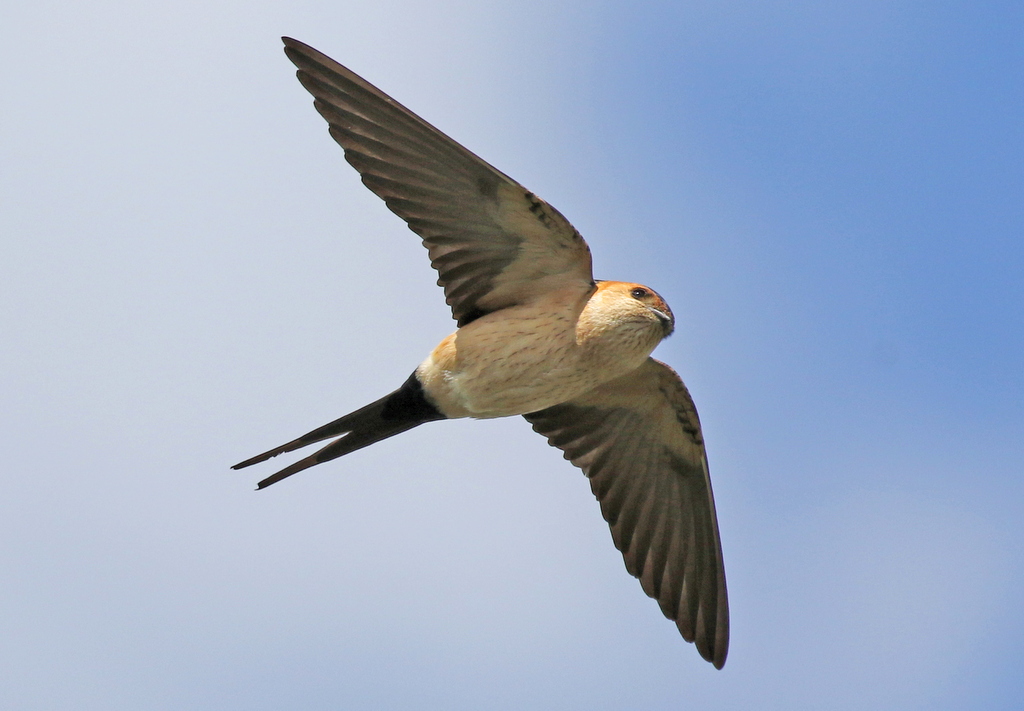
Then a Spanish Imperial Eagle appeared, very high in the sky behind us, just a small dot but we could see the distinctive shape of its wings and the white leading edge to its wings as it turned. It drifted slowly over and then started to display high over the rocks opposite. It twisted and tumbled a couple of times, and then we noticed something come up from behind the trees across the river. It was a second Spanish Imperial Eagle and we were treated to fantastic views as it circled up right in front of us, calling.
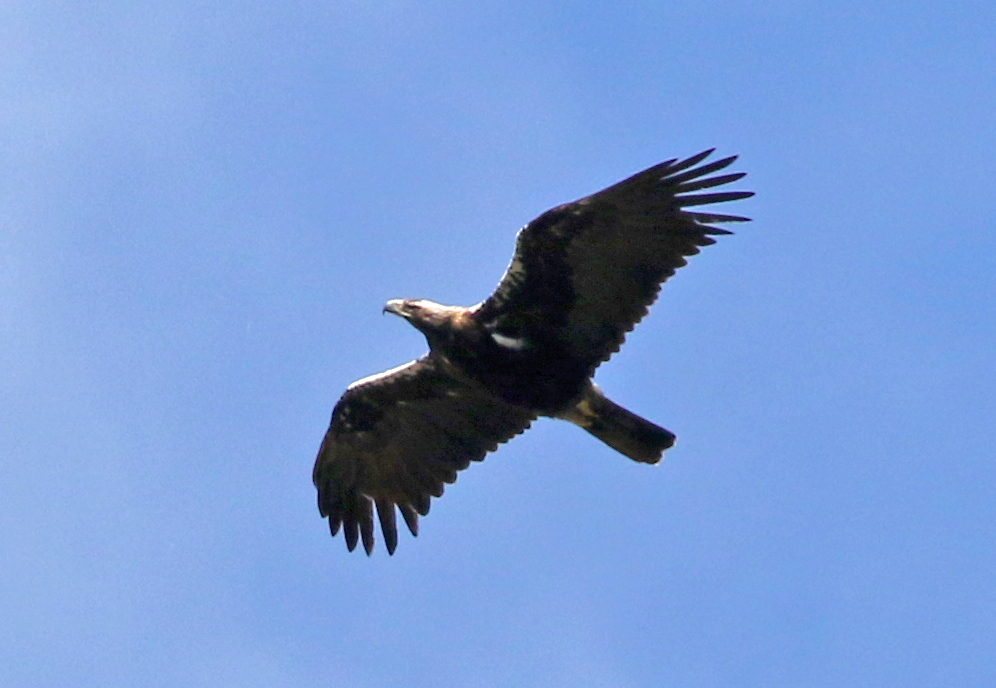
We still had time for a quick stop at Saucedilla on our way back. A Marsh Harrier was quartering the fields by the road on our way to the reserve, the first of several here, and lots of Sand Martins and Barn Swallows were gathered on the wires by the visitor centre. We walked out along the path, but somebody was fishing by the first small pool and there were no birds here today.
Thankfully there was a bit more activity in front of the first hide, with several Purple Herons flying in and out of the reeds, and two Common Kingfishers flying back and forth. Further on, we finally got to see a Zitting Cisticola properly! We could hear Purple Swamphens calling out in the reeds, but just got a brief glimpse of one flying over.
Unfortunately, we didn’t really have enough time to do the reserve here justice today. We decided to have a quick look for Black-winged Kite at a couple of regular spots, but perhaps we were still too early in the day for this typically crepuscular species and we drew a blank. A Eurasian Sparrowhawk flushed from the trees and we passed loads of Cattle Egrets in the fields before we had to turn round and head for home. A Great Peacock Moth was on view back at the hotel, before it was time for dinner.
WEDNESDAY 3RD APRIL
Our first destination for the morning was planned to be the steppes at Campo Lugar but as we drove south from Zorita, we found ourselves heading into increasingly thick fog. We turned back and stopped at the top of the hill to see if it might burn off as the sun rose. There were lots of Northern Wheatears on the short grass among the oaks, migrants stopping off to feed on their way north, along with several White Storks. Crested and Calandra Larks were singing all around and a distant Little Bustard could just be heard calling from somewhere over the hill.
There was no sign of the fog lifting, so we thought we would try Emblase de Alcollarin first instead, as it looked to be clear over in that direction. We drove into the fog again in the village of Alcollarin, but thankfully once we got up to the dam the visibility was much better. There was not much water in the reservoir, after a very dry winter here, but there were still plenty of birds to see. Lots of Great Crested Grebes significantly outnumbered the handful of Little Grebes, and there were a few Eurasian Coot, several Gadwall and three Northern Shoveler scattered around the water.
A Green Sandpiper and two Common Sandpipers were feeding with the Little Ringed Plovers along the shore below us. Right over on the far side, we could see two Wood Sandpipers with a little group of Black-winged Stilts and a very distant Gull-billed Tern resting on a small island. A Common Nightingale was singing from below the dam, presumably an early returnee as this was the only one we would hear all week.
As we drove round to the far end, the more distant arms of the reservoir were bone dry so we didn’t stop, although there were a few Greenfinches and a Woodchat Shrike in the trees as we passed. Thankfully there was still a lot of water in the smaller pool at the furthest end. Several White Storks and Little Egrets were standing on the small dam as we parked in the picnic area and an Egyptian Goose was feeding on the grass below. A Common Kingfisher zipped past and we could hear the White Storks on their nests in the trees bill clapping. Both Willow Warbler and Sedge Warbler were singing by the pool.
The fog appeared still to be getting worse back across the reservoir, so we went for a walk up along the track. A Woodlark was singing, several European Bee-eaters called from somewhere high overhead as they moved through and we could hear a couple of Common Cuckoos too before one flew across in front of us. A Short-toed Eagle hovered over the hillside and we found a couple of Eurasian Spoonbills typically asleep at the back of the pool.
On our way back to the picnic area, we stopped for a moment to watch two male Sardinian Warblers singing in the bushes, before we had a break for coffee. A small warbler with silvery white underparts appeared in the edge of one of the small trees, preening – a Western Bonelli’s Warbler, presumably stopping off on its way up into the hills, and a real bonus to find here.
The fog finally seemed to have lifted, so we decided to try our luck at Campo Lugar. It was the middle of the day now and hot with the sun out. It also didn’t help that the road was unusually busy, with a gang of workmen fixing the badly potholed surface. A Booted Eagle circled up as we passed. There were lots of Meadow Pipits in the fields and a small pale lark flew up from the verge and landed with them, a Greater Short-toed Lark.
Cutting across to the Santa Brava reservoir, we drove down to the dam first. There was a lot more water here, but fewer birds – more Great Crested Grebes and a few Black-headed Gulls. A bizarrely dyed, bright red Feral Pigeon on the building below drew lots of attention and looked very out of place! Eight more European Bee-eaters flew over calling, this time low enough to see as they passed quickly through.
Then we drove back to the picnic area for lunch, stopping briefly to look at two Hoopoes by the road. While we ate, a single Yellow-legged Gull flew across the water and there was time to look more closely at a selection of invertebrates in the short grass, including a basking Western Clubtail and several small Red-underwing Skippers.

After lunch, we drove down through the ricefields. Again with the lack of rain, the channels here were mostly very dry, but we did flush a small group of wagtails from one wet ditch by the road. Two smart male Western Yellow Wagtails of the iberiae race landed out in the field with a few White Wagtails.
The pools just before Madrigalejo did have water in them. When we stopped to photograph some Black-winged Stilts close to the road and found a smart drake Garganey, a couple of Wood Sandpipers and a pair of Little Ringed Plovers too. A Common Snipe darted across but too quick for everyone to get onto. A Willow Warbler was feeding in some sallows, two Zitting Cisticola were collecting nest material and a Eurasian Reed Warbler was singing nearby.

Our next stop was at Moheda Alta. The wind had picked up now, and it was quite breezy up on the bank of the reservoir. Two Shelducks and three Northern Pintail were lingering winter visitors, in with the flock of Mallards. Ten Eurasian Spoonbills included two colour-ringed birds and a flock of Black-winged Stilts flew round. A careful scan of the low muddy islands revealed at least five Little Stints, three Dunlin, several Little Ringed Plovers and four Collared Pratincoles, which we eventually got a good look at in the scope.
To finish the day, we drove up into the edge of the Sierra de Villuercas and stopped at a high pass. Lots of Griffon Vultures were gliding along the ridge, using the updraft from the wind, and a single Egyptian Vulture flew past with them too. As we stood and scanned the surrounding hills, we heard a Crested Tit calling from the trees in front of us. Then it appeared in the branches and we followed it as it worked its way past us.
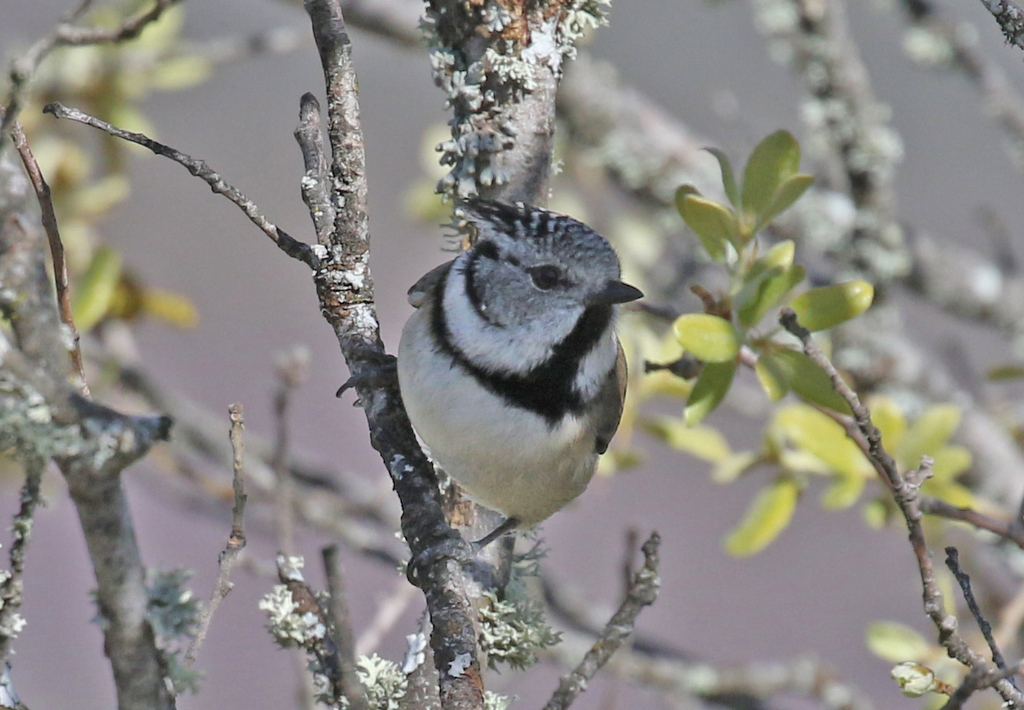
Driving back down a short distance into the trees, we stopped again and found several Eurasian Blackcaps, a Common Chiffchaff, Long-tailed Tits and a European Robin, all feeding quietly in the afternoon sun. A male Cirl Bunting appeared briefly in the treetops too but was very hard to see before it flew further in. Then just as we were leaving, a pair of Cirl Buntings dropped down to feed on the verge beside the road. Then it was time to drive back to the hotel for a refreshing beer before dinner.
THURSDAY 4TH APRIL
Heading south, we made our way out to explore the plains of La Serena. Driving first through a more rocky area, we stopped to admire a Little Owl sunning itself on some rocks by the road, the first of many we would see this morning.
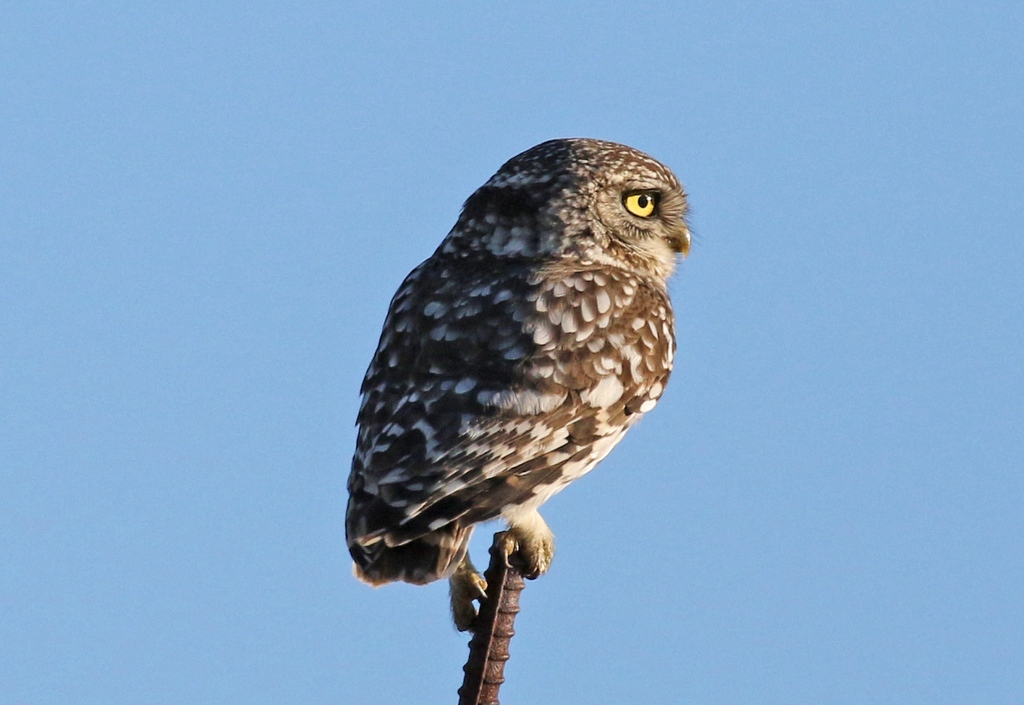
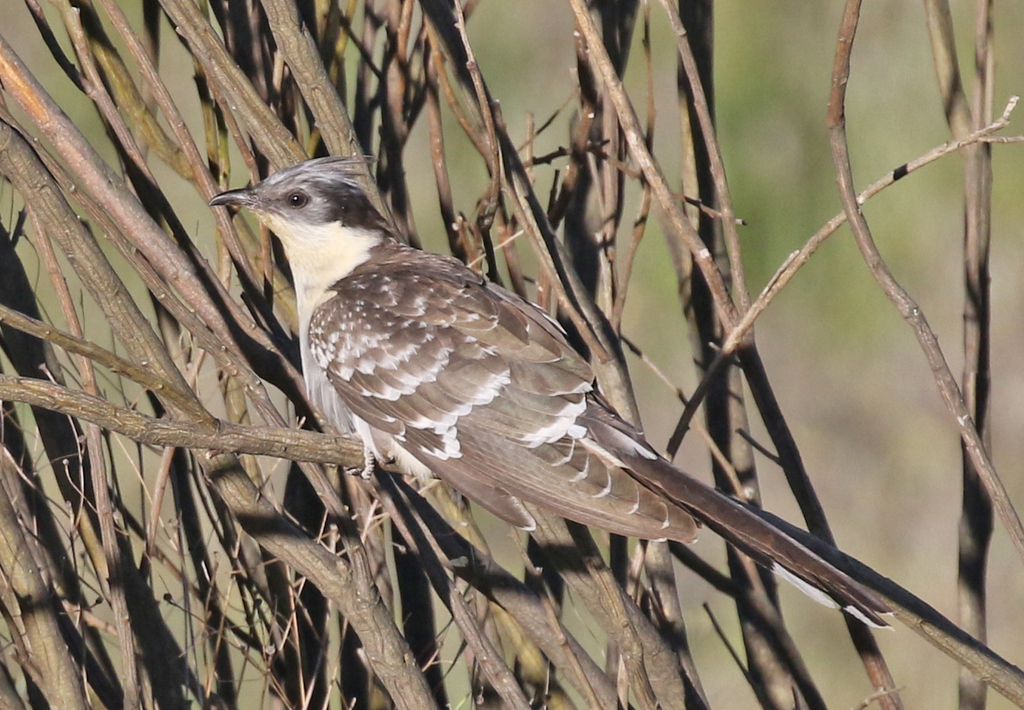
As we got out into a more open cultivated area, we came across our first bustards, starting with a female Little Bustard in a low cereal crop, which flew up as we stopped to look at it, and then a displaying male out in the short grass the other side. Three Great Bustards took off from a field by the road as we passed, flying round behind a low hillside slightly further on.
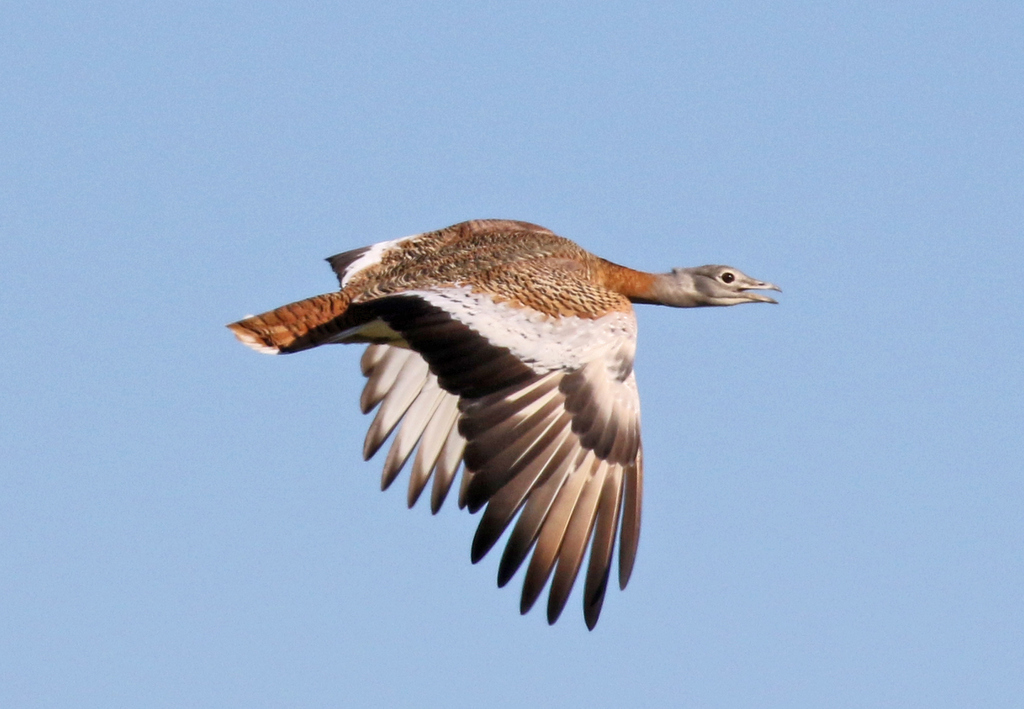
When we drove on and stopped again we could just see them out in the growing wheat, only the heads of two of them showing above the crop. Two more Little Bustards took off from the field the other side and were joined by four more as they flew overhead. A Hoopoe was calling from the top of a road sign and a little further on a group of Lesser Kestrels were flying around an old barn and perching on the low rocks beside the road.
Out on the open plains proper, a smart male Montagu’s Harrier floated past. We could hear Pin-tailed Sandgrouse calling and when we flushed a group of Mallard from a small pool by the road, they were joined by two Pin-tailed Sandgrouse as they flew round.
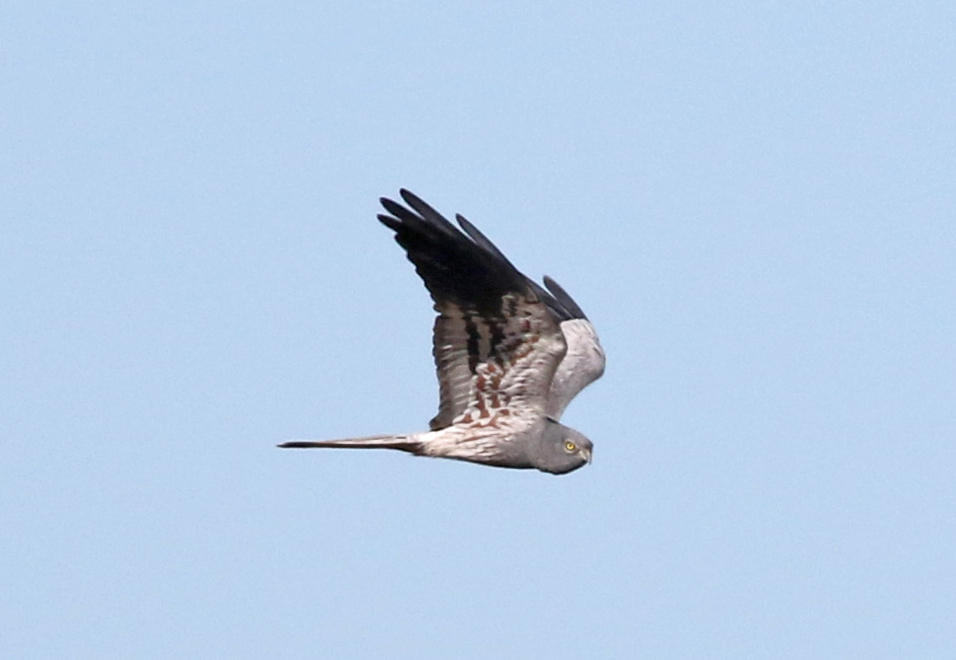
We spotted a couple of Collared Pratincoles hawking for insects and watched as they landed in a sheep field further up the road. We drove on for a closer look and found there were actually twelve of them standing on the close-cropped grass, along with several Little Ringed Plovers.
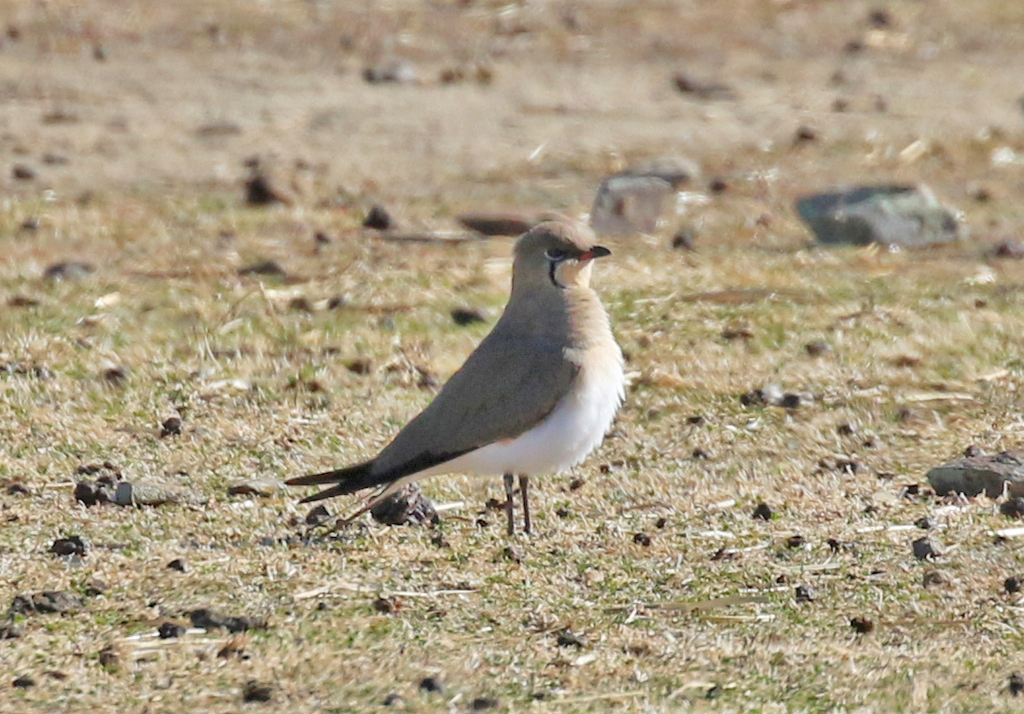
Collared Pratincole – we found twelve in a sheep field
Several Great Bustards were displaying over on a hillside a little further on, so we stopped again to watch. The more we looked, the more we found and by the end we had counted at least thirteen, including several males puffed up in full ‘foam bath’ display, puffed up with their heads pulled in. A flock of European Bee-eaters flew in low over the fields as we drove on, swooping in around the minibus with one attempting to catch an insect right outside the window!
We turned onto a drovers’ track and drove up to a high point to stop for coffee. It was a fantastic view from here, surrounded on all sides by open rolling plains. There were Calandra Larks singing all around us, fluttering up in display flight. We heard more Pin-tailed Sandgrouse calling and turned to see a flock of ten fly up and away. Then we heard the bubbling call of Black-bellied Sandgrouse, and looked over to see two flying across the track, dropping down a couple of fields over. Shortly after, eight Black-bellied Sandgrouse flew up from the same area calling. A small flock of Eurasian Golden Plover flew over too, a winter visitor here with these lingering longer than most.
A male Little Bustard was walking around in the short grass nearby and when we walked over to the top of the ridge try to get it in the scope, one of the group found a striking Red-striped Oil Beetle in the grass. After coffee, we tried another track, but this one was quieter, although a pair of Thekla Larks was feeding by the road.
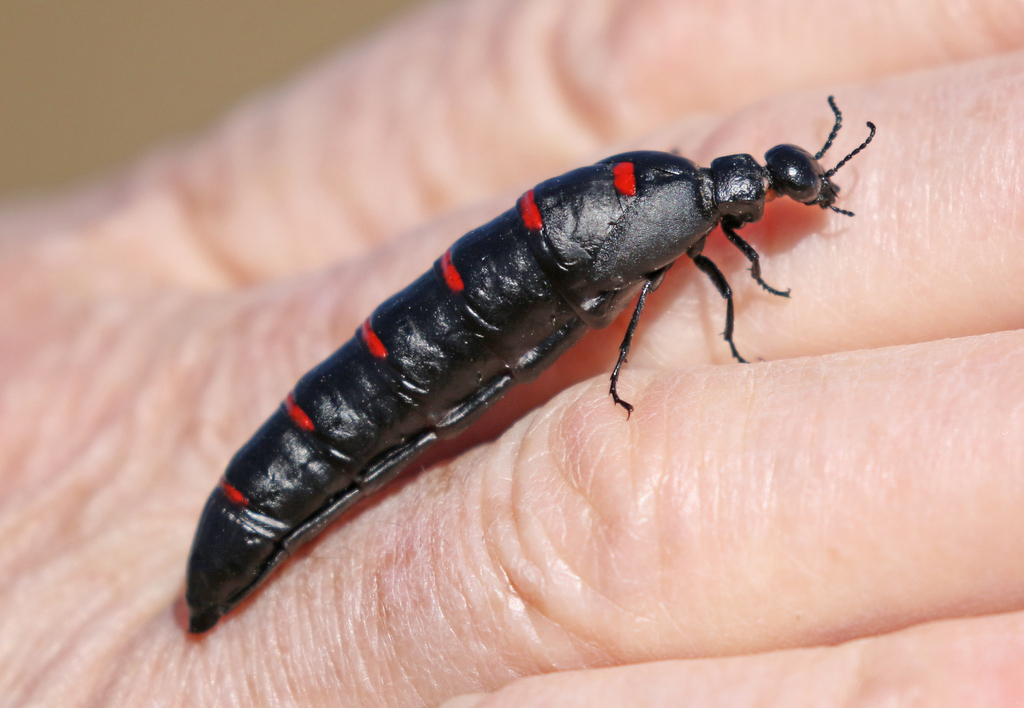
Red-striped Oil Beetle – found in the grass at our coffee stop
After a very productive morning out on the plains, we headed up to the neighbouring sierras. Over lunch in Benquerencia, Crag Martins and Red-rumped Swallows hawked round over the village and two Alpine Swifts flew past. We had planned to walk up to the Castillo but discovered it was closed for repairs, so we stopped briefly to scan the rocky ridge from below. There were lots of Blue Rock Thrushes on the crags and vultures using the updraft – with two Egyptian Vultures among the commoner Griffons.
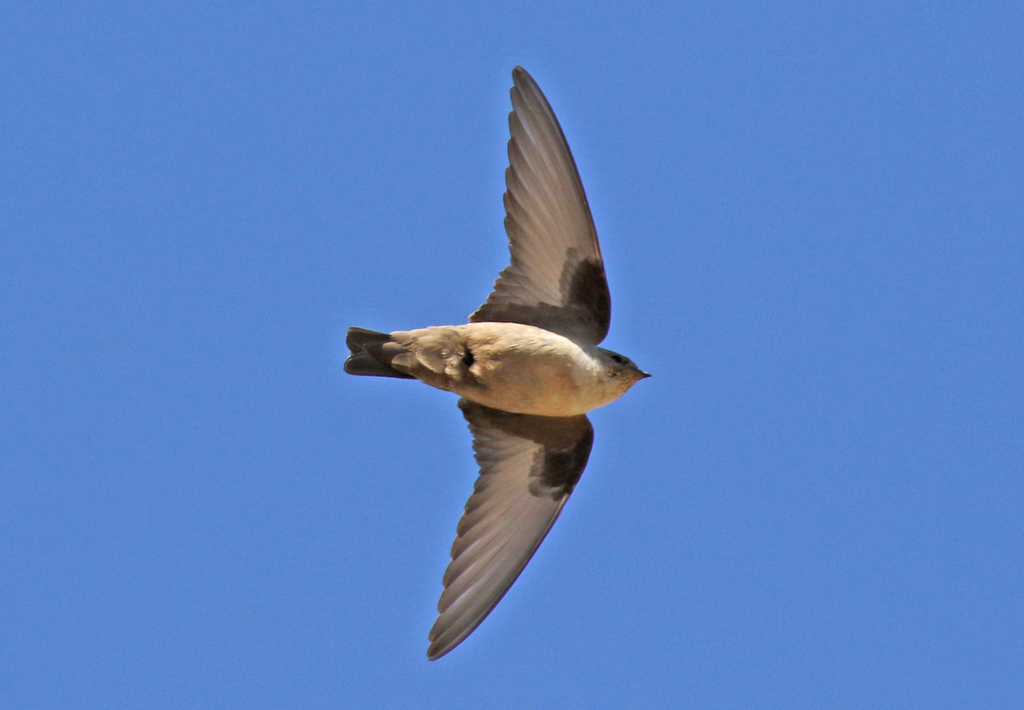
Crag Martin – flying around the village in Benquerencia
We decided to drive over to Alange next. Down at the reservoir, a couple of Gull-billed Terns were patrolling back and forth along the edge and several Thekla Larks were feeding on the rocks. The higher crags were disturbed by several noisy climbers, but we did manage to find a male Rock Bunting right on the very top of one of the points, singing. Even though we couldn’t hear it down below, we could see its bill moving through the scope. We stood for a while on the dam, watching the Alpine Swifts which gave amazing close up views as they came in just below us carrying nest material.
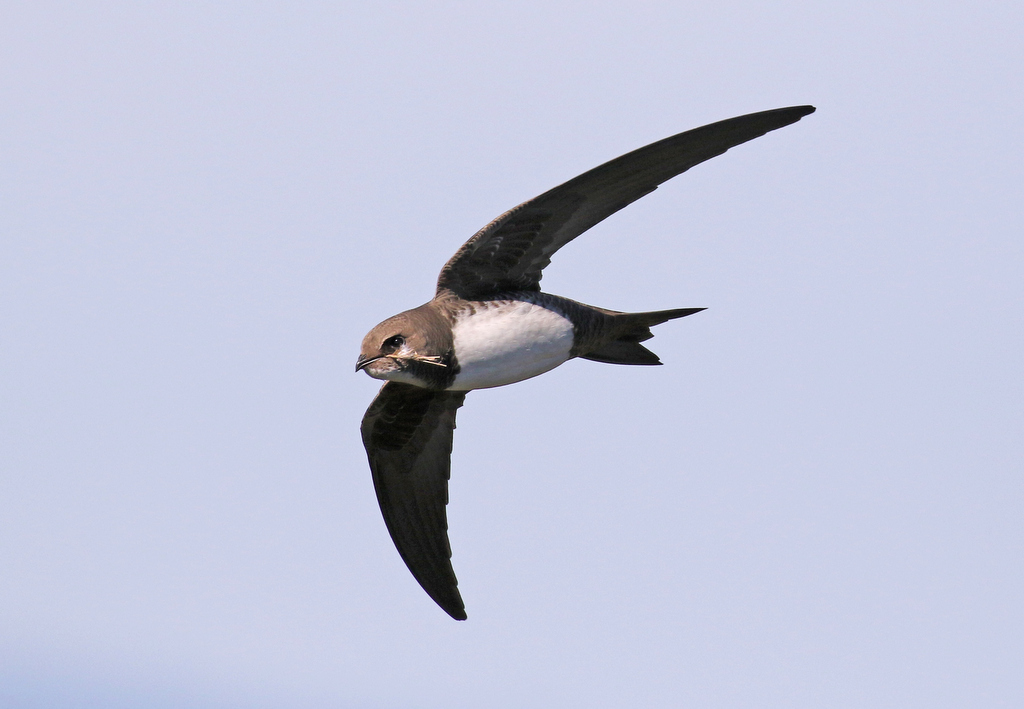
Alpine Swift – coming in to the dam carrying nest material
We still had time for a quick final stop in the city of Mérida on the way back, although we had to battle through considerably more traffic than we had seen for a few days before we eventually found somewhere to park! As we walked out on the old Roman bridge, several Cattle Egrets flew over and from out in the middle of the bridge we could see their nesting colony in the tamarisks growing on one of the islands in the river. A careful scan with the scope, revealed a Black-crowned Night Heron and several Glossy Ibis in with them too. A few Spanish Terrapins were on the rocks below the bridge too. Then it was time to head back to base again.
FRIDAY 5TH APRIL
After rain overnight, we woke to low cloud. We thought we might go for a walk from the hotel first thing, while we waited for it to get properly light but it started spitting with rain again, so we drove into Trujillo instead. The rain stopped as we walked up to the Plaza Mayor, and several Lesser Kestrels circled over the rooftops. From the square, we could see several distant swifts and eventually two flew in and circled in front of the buildings where we could see their paler brown body plumage and large white throat patch to confirm their identity as Pallid Swifts.
From there, we headed out onto the plains towards Santa Marta again. A Stone Curlew flew across in front of us and landed briefly by the track, then ten Black-bellied Sandgrouse flew over, but dropped down and disappeared behind the ridge. We stopped for a scan and found at least nine Great Bustards scattered around the fields, including one male in a small group of four which was giving an impressive full ‘foam bath’ display, shaking its tail feathers at the others. The Little Bustard was still in the same place we had seen it the other day.
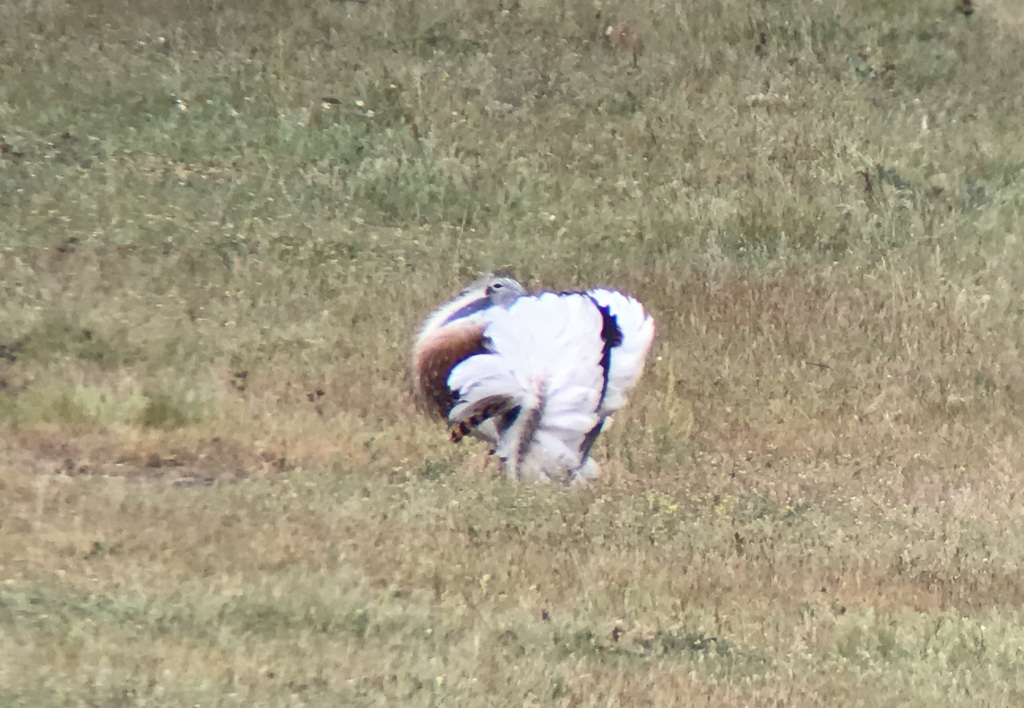
Great Bustard – puffed up, in full ‘foam bath’ display
Back in the minibus, it started to spit with rain again. Crossing the Rio Tamuja on the other side of Santa Marta, we spotted a Green Sandpiper below the bridge as we passed. There were several Jackdaws at the Roller nestboxes on the pylons by the road, but we were still a bit too early for the Rollers to be back in residence. Taking a side road, we stopped to watch a pair of Montagu’s Harriers flying past over the steppe, grey the male following after the female, with Calandra Larks singing all around.
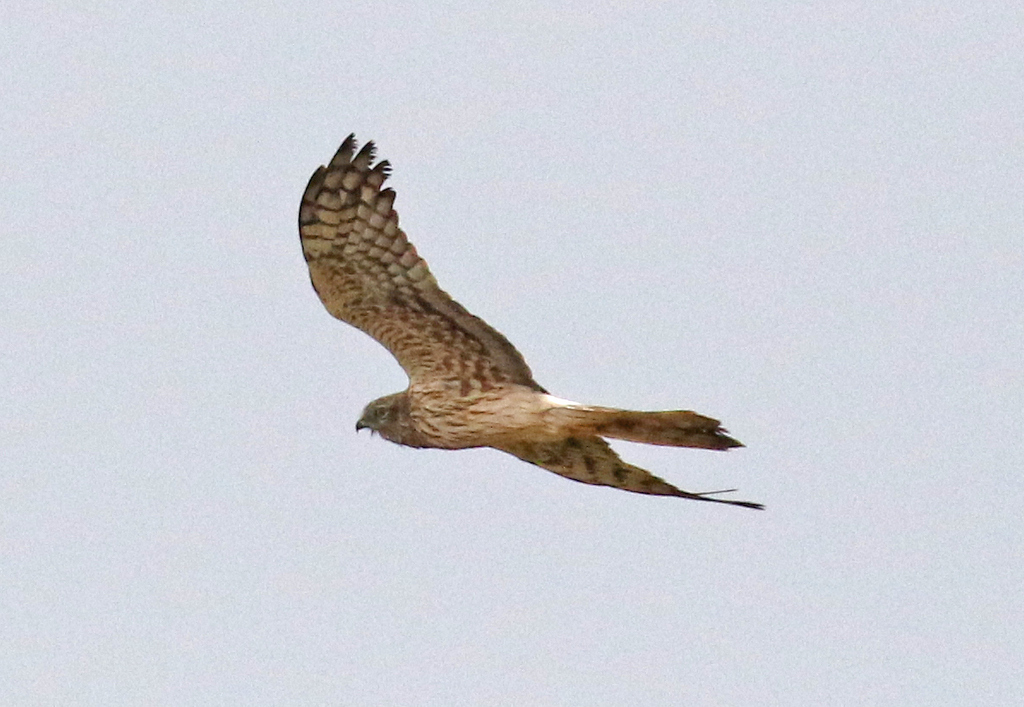
Montagu’s Harrier – the female, crossing the road in front of the minibus
The cloud was breaking up now and slowly clearing from west, so we drove round past Caceres, and up to the Rio Almonte crossing for coffee. Two Alpine Swifts flew over, lots of hirundines were hawking low over the water and two Common Sandpipers flew off calling as we walked down towards the water’s edge. There was no sign of any Black Wheatears here now, although they had been here over the winter, but we did find a male Rock Bunting singing in a tree next to the track.
A quick look at the Embalse de Talavan was not very productive – several Spanish Sparrows were nesting in the bottom of the large White Stork nest by the entrance, and a Great White Egret and Common Sandpiper were down on the shore. So we headed round past Monroy and stopped for lunch at the stone pines with the White Storks on their nests bill clapping above our heads. The photographers headed off to try to get some shots of the local Iberian Magpies but they were typically flighty.
After lunch, we drove on to Serradilla and it was nice and sunny now as we wound our way up the track onto the ridge. Two Eurasian Jays flew across the road as we stopped to scan the crags, a Blue Rock Thrush perched high on the rocks, and as we watched several Sardinian Warblers flying back and forth, two Dartford Warblers appeared too. A Black Vulture and a steady stream of Griffon Vultures flew past along the ridge just above our heads.
We were heading up to the mirador, but a brief wrong turn at least produced a Black Redstart before we found the right track. Then up at the mirador, another Rock Bunting was singing in full view in a small dead tree just below us, giving us our best views yet of this often elusive species. As we stood and admired the stunning view from the top of the ridge, looking out across the dehesa below, a Short-toed Eagle and two Booted Eagles flew past in between the procession of vultures.
Our final destination for the day was Jaraicejo. It was rather windy as we walked along the track but this didn’t seem to put off the male Spectacled Warbler which put on a great display for us, singing and song flighting from the bushes.
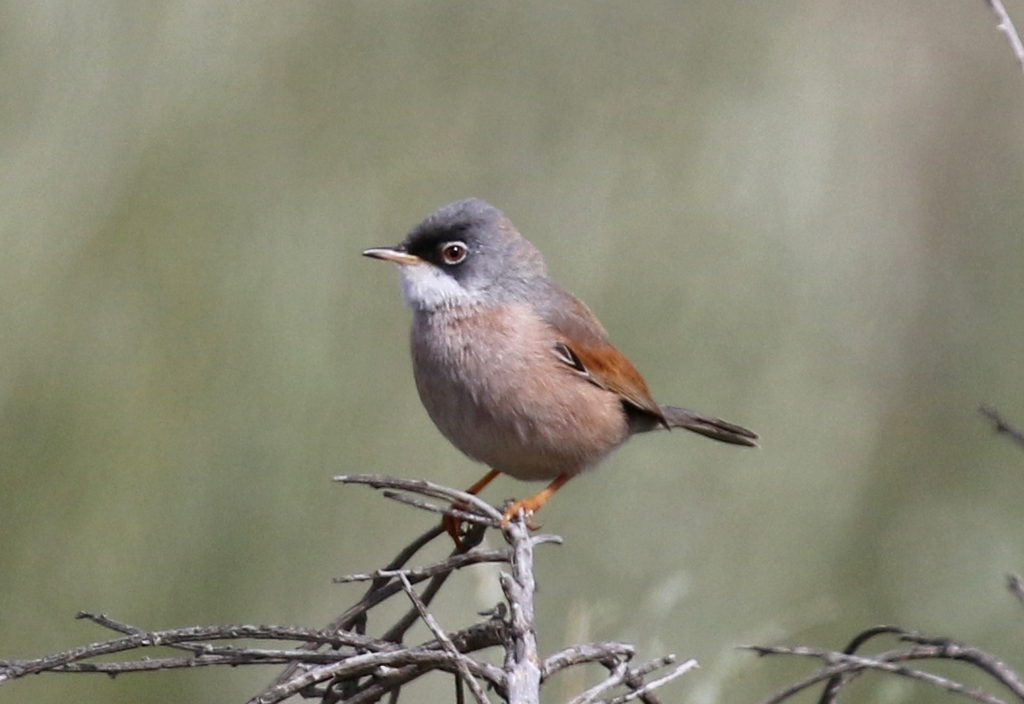
Spectacled Warbler – singing from the top of the bushes
While we were watching it, a male Dartford Warbler appeared too. At first it seemed to be following the Spectacled Warbler, then when it eventually flew away across the track, we realised there was a pair and we watched them feeding together low in the bushes on the other side. It was a nice way to end the day, and it was now time to head back to the hotel for dinner.
SATURDAY 6TH APRIL
Our last morning, we woke to ominous low clouds after more rain overnight. After breakfast and having packed up the minibus, we drove north on the motorway as far as Almaraz. Typically just as we arrived, it started to spit with rain. We stopped at the causeway and, as soon as we got out, we could hear a Savi’s Warbler reeling. We walked back along the road and realised it was quite close, and eventually managed to get good views of it through the scope perched in the top of the rushes. There were also Reed Warblers and Sedge Warblers singing here and the first of many Purple Herons flew over the back of the pool and landed in the reeds.

Savi’s Warbler – reeling from the sedges by the road
Just as everyone had got back into the minibus, we heard a Penduline Tit calling from somewhere across the road. It seemed like it was coming closer, so everyone got out again and we went over to look for it. We did flush a Little Bittern from the reeds by the path, a Gull-billed Tern was hawking over the water and two Eurasian Spoonbills flew past. But there was no further sign of the Penduline Tit and it started to rain more heavily so we made a quick retreat back to the minibus again.
We drove on, up to the edge of Saucedilla village and called in at the visitor centre to get the keys to the hides. Then while we waited for the rain to stop, we drove round to the other side of the reserve. As we approached one of the hides, we noticed a small, pale raptor over the trees beyond, pale grey and white with black shoulders, a Black-winged Kite. Everyone piled quickly out and we eventually got good views, perched in the top of a dead tree and flying round acrobatically, before it disappeared off. A great bird to see and perhaps we had been helped by the rain, which meant it was still out hunting. A female Eurasian Teal on the pool opposite was another late addition to the list and we flushed an Egyptian Vulture from a nearby tree.
Continuing on, there was nothing by the last hide, so we turned round. We still wanted to get a better look at a Purple Swamphen, so we decided to head back to the pools behind the visitor centre. However, while we were driving there, we noticed one standing on the edge of a pool right by the road as we passed, so we stopped quickly and reversed back. It walked back into the reeds as we got out, but then climbed out into the open again where we could all get a good look at it, before flying back over the pool.

Purple Swamphen – on a pool by the road as we drove back
We still had time for a quick look out around the hide behind the visitor centre. Another Savi’s Warbler was reeling here and we had good views of a Sedge Warbler low down on the edge of the reeds. We could hear more Purple Swamphens calling and found one out on the edge of the water in front of the hide, before it walked into the reeds. A Little Bittern flew across the channel and landed on the other side, where it stood in full view for several minutes before eventually flying off again, giving us much better views than the one we had seen only briefly in flight earlier.
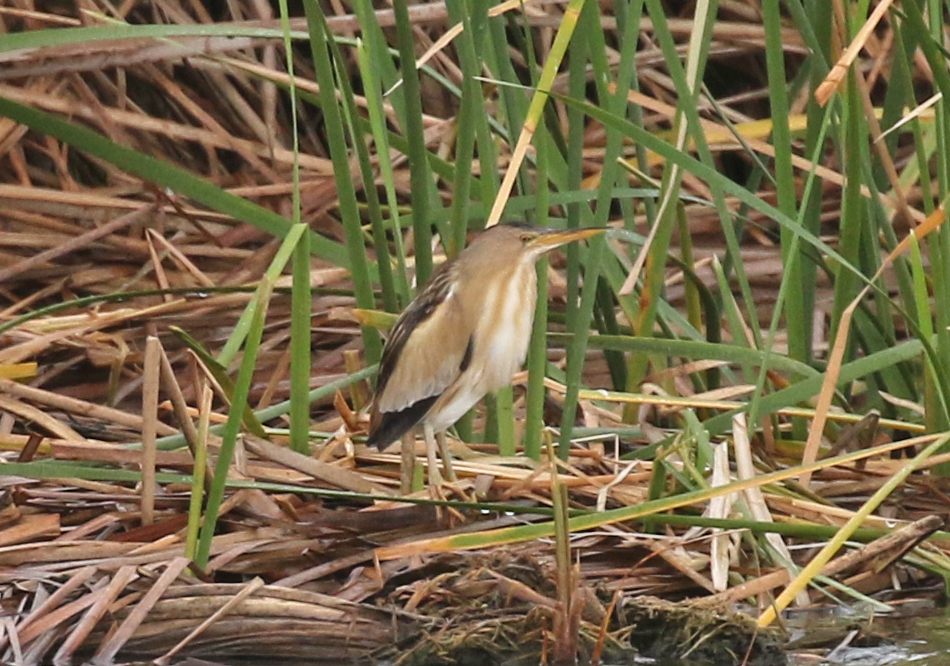
Little Bittern – flew across the channel and landed on the edge of the reeds
While we were admiring all the waterbirds, we noticed some movement in the bushes down below the hide and looked down to see a Subalpine Warbler. This is not where you would normally expect to find one, so presumably it was a migrant which had just stopped off here. It was typically quite skulking at first, but eventually came out where we could all see it.
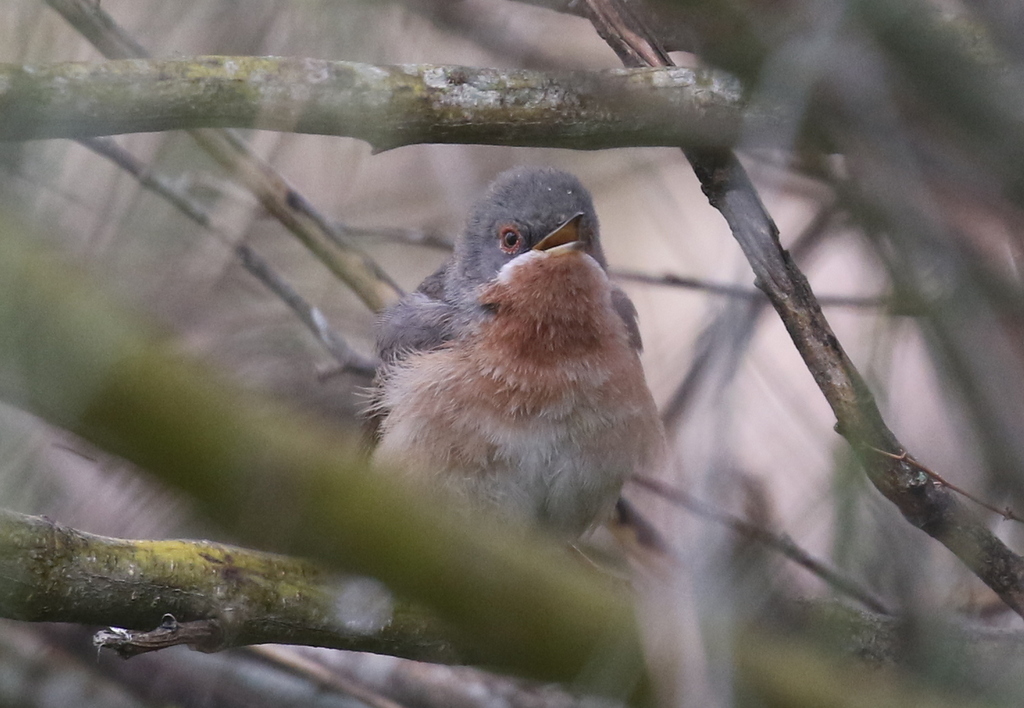
Subalpine Warbler – presumably a migrant, in the bushes at Saucedilla
Then unfortunately we were out of time, and we made our way back to the motorway for the long drive up to Madrid and the flight home.
It had been a wonderful week – great birds, great food, great scenery and great company. We didn’t want to leave! The only thing to do is to plan a return trip next year. If you would be interested in joining us on our next visit to Extremadura in 2020, please get in touch.




